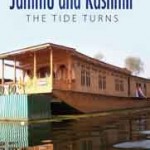IDR Blog
Why India needs a survival strategy
Imperial China first gobbled up pacifist Tibet and now demands major territorial concessions from pacifist India to protect the flanks of the conquered land.
With the imminent withdrawal of the exhausted Western forces from Afghanistan, the emergence of an Islamic Emirate running from Kabul to Islamabad is inevitable. The Pakistan Army will be integral to a design in which the Jihad Factory will ultimately impose its diktat by occupying the ensuing vacuum. The temporary lull on our Western front is misleading and merely a tactical ploy by Pakistan which lies in wait of the final de-induction of the Western Forces. In Afghanistan too, as in Iraq, the Americans will not be allowed a toe-hold after withdrawal. The Islamic Emirate will subsequently spread its tentacles towards Central Asia and India simultaneously, something akin to a ‘hub-and-spoke’ principle.
The ‘Arab Spring’ in the short term may usher in regimes based on democratic norms in some form in Islamic countries in West Asia. However, in the long term, these societies will revert to authoritarianism founded on extreme religious beliefs. Primarily Islamic fundamentalists will ensure that religion will never be delinked from the state in these countries. Delinking of religion from the state is an essential prerequisite for democracy to succeed; failure to do so will entail failures of fruits of democracy, which include modern education to the vast majority. Unemployment, illiteracy and hunger will assist authoritarian forces to regroup and take over again- a vicious cycle. Islamic fundamentalists continue to deceptively consolidate their positions in Turkey and Iraq. This phenomenon is bound to be repeated in Pakistan and Afghanistan once the voices of the small civil society are strangled due to the overwhelming regressive pull of religion.
Democratic India will remain surrounded by authoritarian regimes with extreme religious beliefs or communist dictatorships. These countries being dictatorial in nature have more commonality of purpose amongst themselves than with India. If the liberal federal Indian role model succeeds in Asia, most of these regimes are likely to fall apart or witness increasing internal turmoil. The inherent political contradictions that exist between dictatorship and democracy turn them into natural rivals. Authoritarian regimes based on extreme religious beliefs or communist systems are ruthless and imperial in imposing their agenda on others. They will continue to inflict heavy covert and overt attrition on India as has been done in the past. However, a well-governed and powerful India can be to Asia what America is to the world – a nation that embodies hope, freedom and liberty to all segments of society.
The Union of India, therefore, ought to shift from pacifist philosophies to imperial conduct, if the country is to survive as a nation-state in the 21st century. Pacifist Tibet was conquered with ease by China due to internal bickering, utter confusion and directionless leadership. Similar bewilderment exists in Nepal. The despotic Maoists aided by expansionist Communist China scheme to gradually take over Kathmandu.
In the present century, imperial conduct does not allow physical occupation of another country for long. The stalemate in Iraq and Afghanistan is witness to this phenomenon. However, India’s shift from that of a pacifist to an imperial approach in the conduct of its affairs can ward off the threats surrounding it. This shift in thinking from bickering, bewilderment and confusion to strategic assertion is indispensable.
We had no borders with China until it forcibly occupied Tibet and therefore no territorial concessions are possible. In the event of a war with our neighbours, development of our military capabilities should be such that adequate damage can be inflicted on enemy forces inside their territory. The adversary should be made aware of this strategic assertion. This imperial thinking will lead us to ensure that Tibet ultimately is freed from Chinese control. It is time New Delhi puts the ball back in Beijing’s court by developing the military wherewithal.
The raising of the Strike Corps for deployment on the Chinese front was halted without thought when New Delhi quavered as the media in Communist China objected! Will India shelve the process of acquiring the MMRCA since the government-controlled media in Beijing has declared France as an irresponsible country by agreeing to sell the Rafale to India?
To successfully perpetuate the unity of India as well as defend her growing strategic interests within the region and beyond, rapid modernisation of the Armed Force is an imperative.
In the short term, acquisition of the latest weapon platforms is vital; in the long term, acquiring sunrise defence technologies and establishment of profitable joint ventures with Western partners is the promising route. This will create a win-win situation — military can be equipped with modern weaponry, India can grow as a defence manufacturing hub, it will create millions of new jobs, impart skills to the youth, facilitate the expansion of strategic footprint, and earn huge foreign exchange subsequently, through export of state-of-the-art weapon platforms.
| Editor’s Pick |
In the 1980s, a motivated debate by vested interests was generated over allocation of funds for defence vis-à-vis development. The debate hinged on a falsehood of ‘defence’ or ‘development’, and was fuelled by the argument that as a poor country, India could ill afford allocation of funds demanded by the Indian Armed Forces for their modernisation needs.
Of course, the pacifist rulers neither developed nor prepared the nation adequately for defence.
As India finally shifts gears to acquire Western defence technologies once again, various lobbies are reviving the old ‘defence’ versus ‘development’ debate to stall the modernisation of the armed forces. “We do not have resources in poor India”, is the misleading cry by the pacifists. The fact is that as a country, India is extraordinarily rich – the enormous quantities of money stolen from the treasury and stashed abroad are adequate to ‘defend’ as well as urbanise rural India. The Chinese and Pakistanis chip in conveniently to propagate the falsehood of lifting our populations out of poverty instead of spending money on the arms race, even as they seek a manifold increase in their defence spending.
 Pacifist India has conceded forty per cent of its territory to the Maoists and ten percent to the insurgents. The defence budget presented is neither here nor there. First, the seventeen per cent hike is misleading. In a small budget in comparison to the $106 billion defence budget of China, our 17 per cent hike looks like a drop in the ocean. Second, in the previous year the dollar was pegged at Rs 44.50, while today it is Rs 50 plus, thereby negating any gains claimed in the defence budget.
Pacifist India has conceded forty per cent of its territory to the Maoists and ten percent to the insurgents. The defence budget presented is neither here nor there. First, the seventeen per cent hike is misleading. In a small budget in comparison to the $106 billion defence budget of China, our 17 per cent hike looks like a drop in the ocean. Second, in the previous year the dollar was pegged at Rs 44.50, while today it is Rs 50 plus, thereby negating any gains claimed in the defence budget.
The Prime Minister has stated that he is willing to give three per cent of the GDP to the armed forces for their modernisation programme if needed. At best a doubtful statement. In imperial India, the Prime Minister would have declared that three per cent of the GDP is firmly allotted for the modernisation programme for the next ten years, so that the military can plan, procure, train, and organise itself. Further, he would have appointed the Chief of Defence Staff, integrated the forces for optimal war potential and ensured that the defence headquarters of the three services are integrated with the Ministry of Defence (MoD) in the true sense. In other words, the military would be in the national decision making loop.
Similarly, the MoD instead of being supportive of the armed forces, have botched up and created delays and imbalance in the defence equipment procurement process. The result is that the Indian Army has no modern artillery guns, and ground-based air-defence units are expected to fight with L-60 and L-70 guns of 1970 vintage. With no night vision devices for fifty per cent of the tank fleet, the MoD is wasting the taxpayers’ money. The Indian Air Force (IAF) boasts of a few fighter aircraft but has no basic trainer to train the fighter pilots. Owing to lack of mountain radars, the IAF depends on the ITBP to report aerial incursions on the borders with China. The Indian Navy will receive the second aircraft carrier after great delay but does not have submarines in adequate numbers to provide protection to the battle carrier group.
Pacifist India easily gives up modernisation of the Armed Forces on the slightest protest by the vested interests. Imperial India, on the other hand, will ensure decisive steps to secure its borders as well as the growing strategic interests.
Pacifist India is unable to handle ‘End Use Monitoring’, ‘Logistics Support Agreement’ and ‘Communications Interoperability and Security Memorandum of Agreement’ and thereby avoids taking vital decisions. Imperial India will discern that the modernisation programmes offer a huge market to the Western defence firms. Therefore, it will offer as part of the enticement, a friendly and clean business environment with attractive incentives such that the West cannot afford to ignore investing in the market. This simple strategy will marginalise sanction regimes and make other clauses highly negotiable. While pacifist India will raise useless debates to stall the badly-needed MMRCA, imperial India will stay the course firmly to quickly acquire the MMRCA to enhance the deep offensive capabilities of the IAF.
Unlike Pakistan, which receives weapon platforms through American aid, Indian purchases are ‘cash-and-carry’. Therefore, the only guarantee India needs to offer is assurance that it will not allow transfer of sensitive defence technologies to others. To enable this level of autonomy, the Indian market conditions have to be made extremely lucrative.
At the same time, attractive opportunities must be grabbed!
DRDO reportedly wanted to develop six LPDs similar to USS Trenton. The American company offered to develop the first one in the American shipyard and remaining five in India. It appears that the prevalent clerical mindset in the Indian Government balked and insisted that the first one built in the American shipyard will become too expensive and the deal fell through. However, if we had put our own engineers working side by side to develop the first LPD in the American shipyard, we would have developed enormous skills that could be transferred to the Indian shipyards, instead of reinventing the wheel. At the same time, creation of jobs in the American shipyard would have resulted in substantial goodwill. Sensible strategic ‘give-and-take’ in business yields unprecedented benefits!
Similarly, it is reported that the French offered to transfer the Mirage factory to India at a reasonable cost since they were going to build the Rafale. The proposal was to manufacture the Mirage in India, as also service worldwide, similar old aircraft of other countries. Since there is a ban on transfer of sensitive defence technologies by the West, China steals Western technologies and reverse engineers the same. But pompous and dithering India refused an attractive deal to secure its strategic interests. In business, both sides must reap profits to enable a deal to go through quickly. But Indian pacifists are penny-wise and pound-foolish. They would rather import the laptops from the West, wasting taxpayers’ money and distribute them free as part of the despicable vote bank politics instead of acquiring skills with the help of joint ventures to manufacture them in India.
The gullible and the escapist also overlook the simple fact – that if the Union of India is not defended, there will be nothing left to develop.
On the other hand, imperial India will rise and shine in Asia.
 If pacifist dominance continues unabashed, the Union will fall by the wayside within the next two decades as the surrounding authoritarian forces will succeed in imposing their will to decimate the territorial integrity of our nation. Strategic assertion, therefore, by the GenNext taking over the reins of the nation is indispensable.
If pacifist dominance continues unabashed, the Union will fall by the wayside within the next two decades as the surrounding authoritarian forces will succeed in imposing their will to decimate the territorial integrity of our nation. Strategic assertion, therefore, by the GenNext taking over the reins of the nation is indispensable.
Post your Comment
3 thoughts on “Why India needs a survival strategy”
 Loading Comments
Loading Comments




Thanks for the article.
We need to modernise our infantry level weapons and Surveillance system because our infantry are facing our enemies on daily basis at the border, 365 days.
We should have better weapon system than our enemies at the infantry level.
I would like to mention that our Corporate sector should also be involved for the manufacturing of the defense equipment in line with Modiji’s make in India concept. I have confidence to our engineers and technocrats.
ISRO may also have a greater contribution in the border area Surveillance system. We need to have defense specific satellite in the sky for Surveillance of the border.
Not only India I think an endurance scheme is required for the entire south Asia along other developing countries to make out a fruitful solution of economic fall and other. Thanks for a precious notice.
Good one!